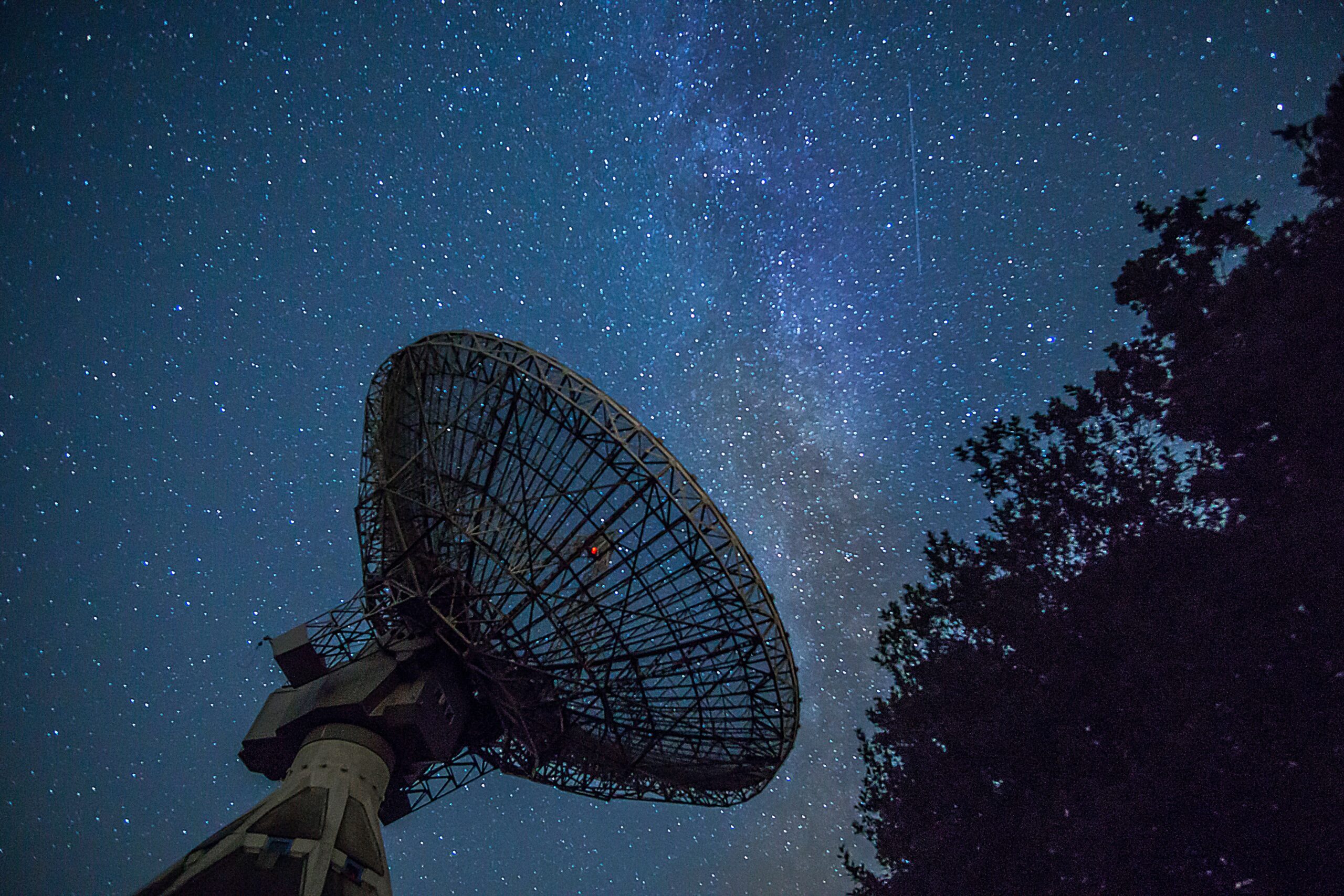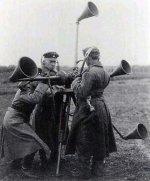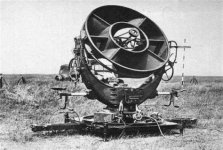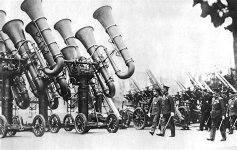I’ve never heard of an aircraft radar at 25GHz, not for navigation, ground or target acquisition. Most target acquisition is near X band.T-38 is the oldest in the lot, remove the radome and there is a .9 meter steerable dish, I think works at 25 GHz
My clearance wouldn't allow me to peek under the hoods of the f-16 and f-35s, but they are far more advanced technology.
You are using an out of date browser. It may not display this or other websites correctly.
You should upgrade or use an alternative browser.
You should upgrade or use an alternative browser.
Spotting USAF aircraft by their radar emissions?
- Thread starter KPMDWhistler
- Start date
KPMDWhistler
Member
Yeah there's a way to use RF broadcasted from big towers around you to get the reflected RF off of aircraft as a way of a passive radar.I suppose there's some way of passively picking up certain aircraft.
I know of certain automobiles being in my neighborhood from I guess their sparkplugs causing interference.
I was pretty sure that is how and why radar was invented.Yeah there's a way to use RF broadcasted from big towers around you to get the reflected RF off of aircraft as a way of a passive radar.
But then I read this stuff. Way older than WWII as I thought (like 1904)?

Who Invented Radar? A Brief History of How Radar Invented
Radar is an object-detection system that uses radio waves to determine the range, angle, or velocity of objects. Read here the history of it
 magnifymind.com
magnifymind.com
Thanks
Joel
You can’t tell what kind of aircraft it is from reflections off radio/TV towers. You can tell from radar returns if you have a database of radar cross section returns to compare with. I spent many weeks measuring and gathering aircraft RCS data for a database to identify various aircraft but it’s a little beyond a home project.Yeah there's a way to use RF broadcasted from big towers around you to get the reflected RF off of aircraft as a way of a passive radar.
I think it really depends on what the OP is trying to do. To try and identify the type of aircraft by radar is going to be tough, BUT, if you want to look at what code they are squawking, it's usually based on the type of aircraft being flown. That might be helpful.You can’t tell what kind of aircraft it is from reflections off radio/TV towers. You can tell from radar returns if you have a database of radar cross section returns to compare with. I spent many weeks measuring and gathering aircraft RCS data for a database to identify various aircraft but it’s a little beyond a home project.
Thanks
Joel
TAC4
Member
Weird post, another way to look at is, the US spends 1 billion per
B2 bomber so it's emissions are nearly impossible to be tracked by the enemy so what makes you think you can track it using
SDR ?
Let's say for entertainment purposes a B2 does infact put out a radar signature in the UHF band or HF band how would you know it was a B2 when you have no baseline to what it is because that information is top secret and not found on the internet ?
Also not sure if military fighters or bombers have ground scanning radar in other words there might be a dead zone say from 100 feet to the ground, so the radar signal would not even reach your antenna at ground level ?
In the end that is why we go to airshows to see this amazing technology up close. If I were you I would just go
to your local international airport and take some great photos of
commercial jets and get a scanner and listen to there air traffic
that way, but that is just me. ✈️
B2 bomber so it's emissions are nearly impossible to be tracked by the enemy so what makes you think you can track it using
SDR ?
Let's say for entertainment purposes a B2 does infact put out a radar signature in the UHF band or HF band how would you know it was a B2 when you have no baseline to what it is because that information is top secret and not found on the internet ?
Also not sure if military fighters or bombers have ground scanning radar in other words there might be a dead zone say from 100 feet to the ground, so the radar signal would not even reach your antenna at ground level ?
In the end that is why we go to airshows to see this amazing technology up close. If I were you I would just go
to your local international airport and take some great photos of
commercial jets and get a scanner and listen to there air traffic
that way, but that is just me. ✈️
Last edited:
KPMDWhistler
Member
When I made this post I had no idea what frequencies USAF aircraft use. Also I wasn't wanting to know exactly what aircraft it was, I just wanted to know that an aircraft was there. During maritime, they wouldn't really have a need to focus their radar to any specific area of the sky, so they would just blast it out just to see what was out there so they can avoid it. This means that if I knew what frequency range a certain aircraft used, then I would be able to detect it. I do see amazing military tech all the time, I live very close to Edwards AFB and Plant 42, so there's no need to really go anywhere when everything flies right over your head on a daily basis. The last time I went to my local military base I took photos of the B-21 sitting on the runway.Weird post, another way to look at is, the US spends 1 billion per
B2 bomber so it's emissions are nearly impossible to be tracked by the enemy so what makes you think you can track using SDR ?
Let's say for entertainment purposes a B2 does infact put out a radar signature in the UHF band or HF band how would you know it was a B2 when you have no baseline to what it is because that information is top secret and not found on the internet ?
Also not sure if military fighters or bombers have ground scanning radar in other words there might be a dead zone say from 100 feet to the ground, so the radar signal would not even reach your antenna at ground level ?
In the end that is why we go to airshows to see this amazing technology up close. If I were you I would just go
to your local international airport and take some great photos of
commercial jets and get a scanner and listen to there air traffic
that way, but that is just me. ✈️
TAC4
Member
Great base !
Not sure what you mean with "maritime".When I made this post I had no idea what frequencies USAF aircraft use. Also I wasn't wanting to know exactly what aircraft it was, I just wanted to know that an aircraft was there. During maritime, they wouldn't really have a need to focus their radar to any specific area of the sky, so they would just blast it out just to see what was out there so they can avoid it. This means that if I knew what frequency range a certain aircraft used, then I would be able to detect it. I do see amazing military tech all the time, I live very close to Edwards AFB and Plant 42, so there's no need to really go anywhere when everything flies right over your head on a daily basis. The last time I went to my local military base I took photos of the B-21 sitting on the runway.
But...
Wanting to know, in general, when an aircraft is there is different than knowing what frequencies it's radar(s) use.
You wont be able to differentiate between military and civilian aircraft with anything other than receiving their transponder code, and knowing what block of codes is assigned to each general type of aircraft.
You could go with the SDR bistatic radar approach, which at one point someone on hackaday (I think) was going to post the code for, but then realized it would violate ITAR (international trafficking in arms regulations).
Which means that unless you are a reasonably good programmer and decent at RF things, you might be better off with an array of directional microphones looking for the specific sounds of jets...
or listening on the radio for tower takeoff clearances.
Even in WW I artillery batteries were located by the sound of the cannons firing with an array of microphones.
Thanks
Joel
Attachments
- Joined
- Dec 19, 2002
- Messages
- 2,459
"Transponder codes" rarely tell you anything about the actual aircraft type. Their assignment is usually assigned by ATC. but if you mean ADS-B ICAO24, then that is a different matter.Not sure what you mean with "maritime".
But...
Wanting to know, in general, when an aircraft is there is different than knowing what frequencies it's radar(s) use.
You wont be able to differentiate between military and civilian aircraft with anything other than receiving their transponder code, and knowing what block of codes is assigned to each general type of aircraft.
You could go with the SDR bistatic radar approach, which at one point someone on hackaday (I think) was going to post the code for, but then realized it would violate ITAR (international trafficking in arms regulations).
Which means that unless you are a reasonably good programmer and decent at RF things, you might be better off with an array of directional microphones looking for the specific sounds of jets...
or listening on the radio for tower takeoff clearances.
Even in WW I artillery batteries were located by the sound of the cannons firing with an array of microphones.
Thanks
Joel
Many US fighter aircraft radar for target acquisition and tracking through the 1990s was in X band and so are some air to air missiles that operate along with the aircraft radar. I worked with parts of the F14, F15 and Phoenix missile radar many years ago. Depending on what an aircraft is doing its targeting radar may or may not be in use.
Similar threads
- Replies
- 0
- Views
- 139
- Replies
- 9
- Views
- 518
- Replies
- 8
- Views
- 1K




